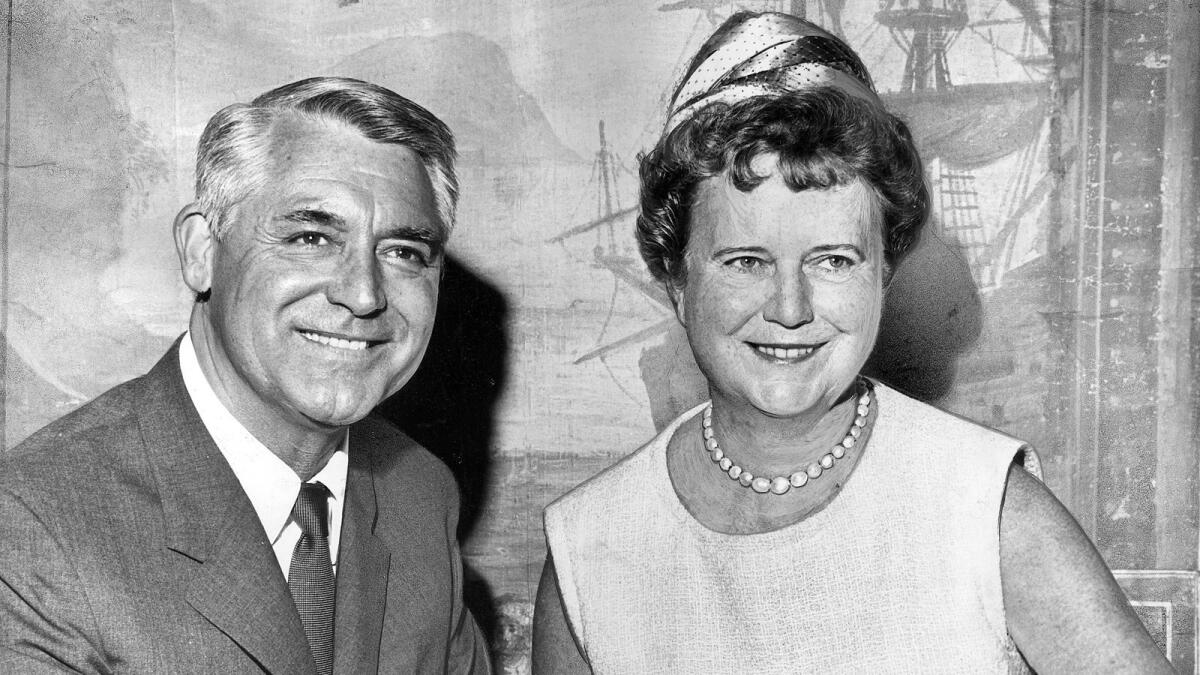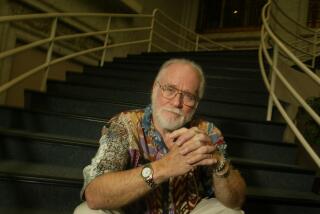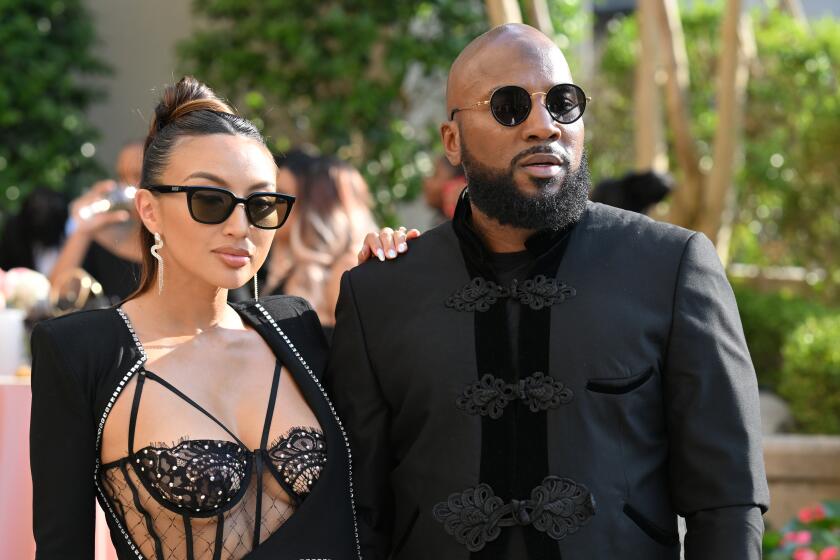Dorothy Buffum Chandler was the driving force behind the Music Center

In summer 1951, Los Angeles’ music scene was floundering. The L.A. Philharmonic played out of a sonically inadequate auditorium leased from the Temple Baptist Church downtown. The Hollywood Bowl was deep in debt. Only four days into its season, it closed.
Dorothy Buffum Chandler, wife of L.A. Times publisher Norman Chandler and a new member of the Hollywood Assn. board, headed up an emergency committee that held a series of Save the Bowl concerts. “Buff,” as she was often called, enlisted conductor Alfred Wallenstein and wrangled artists such as Jascha Heifetz and Gregor Piatigorsky to play free.
The Bowl not only reopened later that summer but also ended its season in the black — and earned Chandler a reputation as a relentless, savvy fundraiser. She soon turned her attention toward finding a permanent home for the L.A. Phil, embarking on what would become a near-decade-long quest to will the Music Center into existence.
Even as a young student at Long Beach High, the blue-eyed fresh-faced Dorothy Buffum, heir to Buffum’s department stores, was a force to be reckoned with. She was socially shy at times but competitive with the boys in track and field.
“I loved being a sprinter and a hurdler, and I usually out-ran the boys,” she said at a 1959 meeting of the Southern California Symphony Assn.
Running with the boys again later in life, Chandler showed the same ambition and determination in her fundraising for the Music Center. The campaign she led resulted in about $19 million in private donations — equivalent to about $146 million today — and a permanent home for the L.A. Phil. It was a feat that Time magazine called, in a 1964 cover story about Chandler, “perhaps the most impressive display of virtuoso money-raising and civic citizenship in the history of U.S. womanhood.”
Chandler rallied communities divided by religion and geography but bound by a love of music. Much of the country had seen L.A. as an artistically barren desert compared with more urbane San Francisco and New York, and in 1964 the new Music Center crystallized the city’s new identity.
“Dorothy Chandler played a major role in bringing Los Angeles to a new level of confidence and self-esteem as a world city,” USC history professor and author Kevin Starr says. “It was part of a larger pattern — there was also the coming of the Dodgers, the rise of the L.A. Times to national prominence, the emergence during World War II of Greater Los Angeles as the Gibraltar of the Pacific — all part of a mosaic that saw L.A. make the transition from a regional capital to a national capital en route to becoming a global capital.”
A divided L.A.
Advocating for the arts in the early 1950s was studded with political challenges, said Rosalind Wyman, a councilwoman at the time.
“There were people on the City Council during the time I served that believed you shouldn’t spend any money on the arts,” Wyman says. “Then there were people like me, who felt the opposite — and Buff was a real leader, she turned people around, she was tenacious. She believed you didn’t have a major city unless you had major arts.”
Los Angeles was a deeply divided city then, with “old money” families entrenched in Pasadena and San Marino and a Jewish community, newly prosperous from work in the motion-picture industry, on the Westside. Anti-Semitism was rampant, historian Starr says, but Chandler blurred ethnic and geographical boundaries, venturing into what was considered a Jewish country club, Hillcrest, to meet potential donors. In doing so, she changed the social landscape of the city.
“She helped pull those worlds together,” Starr says. “The Music Center was a reconciling force.”
March became Chandler’s lucky month. On St. Patrick’s Day 1955 at the Ambassador Hotel, she threw the Eldorado party, an early fundraiser for the Music Center. Jack Benny, Danny Kaye and Dinah Shore performed free, General Motors donated a Cadillac Eldorado to be raffled off, and the party raised a staggering $400,000, about $3.6 million today.
Again in March — this time 1959 — Chandler went before the Los Angeles County Board of Supervisors and pledged to raise $4 million of the $10 million thought needed to build the orchestra’s new home. Chandler suggested the county-owned land atop Bunker Hill in downtown L.A. as a potential site. So taken were the supervisors with the prospect of private donations helping to fund a public building, they offered to pay architect Welton Becket’s fee.
In March 1961, inspired by a visit to a London theater, Chandler proposed to the supervisors that two additional buildings be built, turning the Music Center into an arts complex that also showcased theater. She pledged to raise $11 million against a new estimated cost of $25 million. (In the end, her fundraising covered more than half of the final construction cost of $35 million.)
These deals paved the way for a funding model that is still considered groundbreaking, says Howard Sherman, the Music Center’s chief operating officer.
“She envisioned the whole public-private partnership, and no one had ever done that before,” Sherman says. “Even today, you just don’t see that level of county support, based on what Ms. Chandler set up, in arts institutions.”
‘You can do better’
“Mrs. C,” as she was also called, turned the pool house of her Hancock Park home into her headquarters for the next decade and beyond. She enlisted an army of friends and volunteers to work the phones and pen solicitation and thank-you letters.
Chandler frequently hit up wealthy friends for steep or multiple donations. She sometimes tore up checks in front of donors’ faces and asked for more.
Anne Douglas, wife of Kirk Douglas, was a close friend. In 1968 she became first co-president of a Music Center fundraising engine, the Amazing Blue Ribbon 400.
“She wrote my husband a letter for some funds, and he obeyed and sent her a $10,000 check,” Douglas recalls. “He got the check back with a note: ‘Kirk, you can do better.’ He sent her $20,000. She did that with everyone.”
Walter Mirisch, who produced the Academy Award best picture winner “In the Heat of the Night” in 1967, remembers the time Chandler visited him and his brother Harold at Samuel Goldwyn Studio asking for a contribution.
“She was imbued with a messianic spirit to build the Music Center and made a concentrated effort to bring in people from the entertainment industry,” Mirisch says.
MCA head Lew Wasserman became a fervent, longtime supporter. Cary Grant and Nat King Cole delivered checks for $25,000 — Chandler’s minimum to be considered a Founder — in 1962, after Music Center construction began. In 1963, a $250-a-head benefit premiere of 20th Century Fox’s “Cleopatra” brought in $1 million. Walt Disney designed the now-famous “buck bags,” which in 1964 were toted around by Chandler-organized volunteers requesting dollar bills for the newly opened Music Center.
Chandler had access to the city’s movers and shakers, but it was her psychological savvy during one-on-one fundraising meetings over lunch at her favorite restaurant, Perino’s, that may have been her greatest weapon. She’d often play potential donors against one another, says Claire Segal, who worked with Chandler as Music Center director of public affairs and marketing from 1979 to 1987.
“She went to Mark Taper and said, ‘I’m getting a million dollars from Howard Ahmanson.’ Then she went to Howard and said, ‘I’m getting a million dollars from Mark.’ She told me that story,” Segal says.
A desire for more
Chandler may have also had a personal motivation behind her civic passion. In the early ‘30s, she suffered a nervous breakdown and spent six months in a private psychiatric clinic in Pasadena. She had married into a wealthier family, and though she had a loving relationship with her husband, she felt intimidated by his sisters not to mention bored by the bridge-playing society women she was expected to join. She wanted more out of life.
When Chandler finished her therapy, she had newfound confidence and peace of mind. Some have speculated that her civic zeal and determination to succeed, flying in the face of the Chandler family, might have been an “I’ll show them” of sorts.
When the Music Center opened, it was both a citywide achievement and a personal triumph. Bob Hope emceed the outdoor dedication ceremony held in the plaza that September. On Dec. 6, during opening night of the Memorial Pavilion (later renamed the Dorothy Chandler Pavilion), Chandler worked the crowd in a gold brocade floor-length gown and diamond choker. Zubin Mehta, the 28-year-old wunderkind whom she’d personally brought on three years earlier to be associate conductor (prompting music director Georg Solti to quit), conducted.
In a recent interview, Mehta remembers that as the orchestra launched into Richard Strauss’ “Fanfare,” Chandler sat in the front row of the founders circle, stage left, beaming.
“My speech was after the opening piece,” Mehta says. “I said: ‘Gentlemen, we love the acoustics! Egypt has its pharaohs, Florence has its princesses. Los Angeles has one simple lady, called Dorothy Chandler.’ ”
At which point Chandler got a rousing, minutes-long standing ovation. Otis Chandler tugged his blushing mother to her feet.
“It was her evening,” Mehta says. “It was also a time when women weren’t in such leading roles, and she was a great exception. She left two legacies, for women and for culture.”
With her Music Center up and running, Chandler was especially supportive of experimentation, recalls Gordon Davidson, whom Chandler appointed as artistic director of her new Mark Taper Forum. Davidson says that opening night of the Taper in 1967 was almost the theater’s last, as he chose to put on John Whiting’s play, “The Devils,” about a nun who has sexual relations with a priest.
“Los Angeles back then had a provincial view of what theater might be,” Davidson says. “Gov. Reagan was seen walking up the aisle at intermission with his wife and didn’t come back! But it turned out Dorothy was supportive of experimentation. She gave me absolute creative freedom.”
Partly in response to opening night’s controversy, Chandler asked studio chief Wasserman to serve as president of the Center Theatre Group board, Davidson says, “so we’d have protection. With that kind of strength, we were off to a great running start.”
Even in her golden years, Chandler had a firm hand in overseeing the Music Center board. Burt Lancaster, who was on the board in the early ‘80s but rarely came to meetings, showed up once out of the blue, Segal recalls. Chandler showed her displeasure over his previous lack of attendance and scolded him, jokingly, for not wearing a jacket or tie.
“Burt was not a person easily intimidated,” Segal says, “but I think she rattled him.”
When Chandler made requests of county officials and potential donors, some no doubt felt an implicit pressure to acquiesce. The Chandler family was a powerful media force and the region’s most influential family of the day. Chandler was also not beyond trying to use The Times’ pages to forward her cultural agenda, says Martin Bernheimer, who was the paper’s music critic for 31 years. He started in 1965 just after the Music Center opened.
“She was not happy with me because I didn’t jump up and down and support all her projects,” Bernheimer says. “She loved Zubin Mehta, and I didn’t love him enough to please her. There are stories — though they never reached me directly — that she wanted me fired.”
Ever a visionary
One afternoon in the early ‘80s, Chandler strode across the Music Center plaza with Joan Boyett, whom she had tapped as the executive director of the Music Center Education Division in 1979.
“Mrs. Chandler stopped and looked eastward. She said: ‘Someday the Music Center is going to be connected to City Hall with a park.’ She had this look of the future on her face, that this was going to happen — and it did,” Boyett says, referring to the area that opened as Grand Park in 2012. “She was a visionary.”
When Chandler died in 1997, at 96, Gov. Pete Wilson said in his eulogy that she was “the heart and soul of Southern California’s cultural life.”
Chandler was far more modest. During the celebratory champagne dinner after the Music Center’s opening-night concert, held upstairs at the Pavilion’s restaurant, Chandler raised her glass in a toast.
“What is important here tonight is not the fundraising or the building that we are in,” she said. “The only really important thing here, tonight, is the music we heard performed. That will go on forever.”
More to Read
The biggest entertainment stories
Get our big stories about Hollywood, film, television, music, arts, culture and more right in your inbox as soon as they publish.
You may occasionally receive promotional content from the Los Angeles Times.







